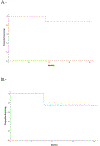Organ preservation for patients with anterior mucosal squamous cell carcinoma of the nasal cavity: Rhinectomy-free survival in those refusing surgery
- PMID: 30933393
- PMCID: PMC6709873
- DOI: 10.1002/hed.25751
Organ preservation for patients with anterior mucosal squamous cell carcinoma of the nasal cavity: Rhinectomy-free survival in those refusing surgery
Abstract
Background: Standard treatment of squamous cell carcinoma (SCC) of the anterior nasal mucosa is surgical resection with or without postoperative radiation.
Methods: Retrospective review of patients diagnosed with SCC of the nasal cavity between January 2000 and July 2018 who refused total rhinectomy and who were treated with radiation with or without chemotherapy with curative intent.
Results: Eleven patients were identified, 73% had stage III or stage IV disease. Four patients were treated with intensity-modulated radiotherapy and seven with intensity-modulated proton radiotherapy. Concurrent chemoradiotherapy was used in nine patients (82%). With a median follow-up of 15 months (3-124 months), two patients experienced recurrence and one developed distant metastasis and died from disease. The 2-year rhinectomy-free survival rate was 88%. Two-year overall survival and recurrence-free survival were 100% and 75%, respectively.
Conclusion: A radiation-based approach for SCC of the nasal cavity mucosa is a valid option for selected patients who refuse up-front surgery.
Keywords: nasal cavity; outcomes; radiotherapy; rhinectomy; squamous cell carcinoma.
© 2019 Wiley Periodicals, Inc.
Figures
References
-
- Sanghvi S, Khan MN, Patel NR, Yeldandi S, Baredes S, Eloy JA. Epidemiology of sinonasal squamous cell carcinoma: a comprehensive analysis of 4994 patients. The Laryngoscope. 2014;124(1):76–83. - PubMed
-
- Dulguerov P, Jacobsen MS, Allal AS, Lehmann W, Calcaterra T. Nasal and paranasal sinus carcinoma: are we making progress? A series of 220 patients and a systematic review. Cancer. 2001;92(12):3012–3029. - PubMed
-
- Scurry WC Jr., Goldenberg D, Chee MY, Lengerich EJ, Liu Y, Fedok FG. Regional recurrence of squamous cell carcinoma of the nasal cavity: a systematic review and meta-analysis. Archives of otolaryngology--head & neck surgery. 2007;133(8):796–800. - PubMed
-
- Siddiqui F, Smith RV, Yom SS, et al. ACR appropriateness criteria (R) nasal cavity and paranasal sinus cancers. Head Neck. 2017;39(3):407–418. - PubMed
-
- Robbins KT, Ferlito A, Silver CE, et al. Contemporary management of sinonasal cancer. Head & neck. 2011;33(9):1352–1365. - PubMed
Publication types
MeSH terms
Substances
Grants and funding
LinkOut - more resources
Full Text Sources
Medical
Research Materials


